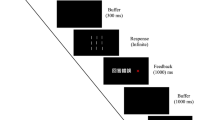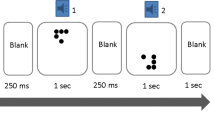Abstract
Visually mediated processes including, exposure to print (e.g. reading) as well as orthographic transcription and coding skills, have been found to contribute to individual differences in literacy development. The current study examined the role of visuospatial working memory (WM) in underpinning this relationship and emergent writing. One hundred and forty-three children in their first year of the UK educational system participated. Hierarchical regressions revealed that visuo-spatial WM predicted a unique proportion of the variance in spelling and independent text writing ability after nonverbal cognitive ability, phonological WM, visual perceptual processing and orthographic transcription skills had been taken into account. Further, they also revealed for the spelling of individual words the unique contribution made by short-term memory retention of the orthographic structure of those words is particularly important. This contrasted with the unique contribution of short-term visuo-spatial coding of novel and unfamiliar visual stimuli for the development of independent writing skills.
Similar content being viewed by others
References
Adams, M. (1990). Beginning to read: Thinking and learning about print. Cambridge, MA: MIT Press.
Alloway, T. P. (2007). Automated working memory assessment. London: Harcourt.
Alloway, T. P., & Alloway, R. G. (2010). Investigating the predictive roles of working memory and IQ in academic attainment. Journal of Experimental Child Psychology, 106, 20–29.
Alloway, T. P., Gathercole, S. E., Adams, A-M., Willis, C., Eaglen, R., & Lamont, E. (2005). Working memory and phonological awareness as predictors of progress towards early learning goals at school entry. British Journal of Developmental Psychology, 23, 417–426.
Baddeley, A. (1986). Working memory. Oxford: Oxford University Press.
Baddeley, A. (2000). The episodic buffer: A new component of working memory? Trends in Cognitive Science, 4, 417–423.
Barker, T. A., Torgesen, J. K., & Wagner, R. K. (1992). The role of orthographic processing skills on five different reading tasks. Reading Research Quarterly, 27, 335–345.
Berninger, V. W. (1987). Global, component, and serial processing of printed words in beginning readers. Journal of Experimental Child Psychology, 43, 387–418.
Berninger, V. W. (1999). Coordinating transcription and text generation in working memory during composing: Automatic and constructive processes. Learning Disability Quarterly, 23, 99–112.
Berninger, V. W. (2009). Highlights of programmatic, interdisciplinary research on writing. Learning disabilities: Research and Practice, 24, 68–79.
Berninger, V. W., Mizokawa, D. T., & Bragg, R. (1991a). Theory-based diagnosis and remediation of writing disabilities. Journal of Educational Psychology, 29, 57–59.
Berninger, V., Vaughan, K., Abbott, R., Begay, K., Byrd, K., Curtin, G., Minnich, J., & Graham, S. (2002). Teaching spelling and composition alone and together: Implications for the simple view of writing. Journal of Educational Psychology, 94, 291–304.
Berninger, V. W., Yates, C., & Lester, K. (1991b). Multiple orthographic codes in reading and writing acquisition. Reading and Writing: An Interdisciplinary Journal, 3, 115–149.
Bourke, L., & Adams, A.-M. (2003). The relationship between working memory and early writing assessed at the word, sentence and text level. Educational and Child Psychology, 20(3), 19–36.
Bourke, L., & Adams, A.-M. (2010). Cognitive constraints and the early learning goals in writing. Journal of Research in Reading, 33(1), 94–110.
Castles, A., & Nation, K. (2006). How does orthographic learning happen? In S. Andrews (Ed.), From inkmarks to ideas: Current issues in lexical processing (pp. 151–179). New York, NY: Psychology Press.
Chenoweth, N. A., & Hayes, J. R. (2003). The inner voice in writing. Written Communication, 20(1), 99–118.
Conrad, N. J., Harris, N., & Williams, J. (2012). Individual differences in children’s literacy development: The contribution of orthographic knowledge. Reading and Writing, published online: 19 September 2012. doi:10.1007/s11145-012-9415-2.
Conrad, N. J., & Levy, B. A. (2007). Letter processing and the formation of memory representations in children with naming speed deficits. Reading and Writing, 20, 201–223.
Conway, A. R. A., Cowan, N., Bunting, M. F., Therriault, D. J., & Minkoff, S. R. B. (2002). A latent variable analysis of working memory capacity, short-term memory capacity, processing speed and general fluid intelligence. Intelligence, 30, 160–183.
Cowan, N. (2010). Multiple concurrent thoughts: The meaning and developmental neuropsychology of working memory. Developmental Neuropsychology, 35(5), 447–474.
Cunningham, A. E., & Stanovich, K. E. (1993). Children’s literacy environments and early word recognition skills. Reading and Writing: An Interdisciplinary Journal, 5, 193–204.
Daneman, M., & Carpenter, P. A. (1980). Individual differences in working memory and reading. Journal of Verbal Learning and Verbal Behaviour, 19(4), 450–466.
Dockrell, J., Lindsay, G., Connelly, V., & Mackie, C. (2007). Constraints in the development of writing skills in children with specific language impairments. Exceptional Children, 73(2), 147–164.
Dyson, A. H. (1992). Multiple worlds of child writers: Friends learning to write. New York: Teachers College Press.
Ehri, L. C. (1980a). The development of orthographic images. In U. Frith (Ed.), Cognitive processes in spelling. London: Academic Press.
Ehri, L. C. (1980b). The role of orthographic images in learning printed words. In J. Kavanagh & R. Venezky (Eds.), Orthography, reading and dyslexia. Baltimore, MD: University Park Press.
Ehri, L. C. (1995). Phases of development in learning to read words by sight. Journal of Research in Reading, 18(2), 116–125.
Ehri, L. C. (2005). Learning to read words: Theory, findings and issues. Scientific Studies of Reading, 9(2), 167–188.
Engle, R. W., Tuholski, S. W., Laughlin, J., & Conway, A. R. A. (1999). Working memory, short-term memory and general fluid intelligence: A latent variable model approach. Journal of Experimental Psychology: General, 128, 309–331.
Frith, U. (1985). Beneath the surface of developmental dyslexia. In K. Patterson, J. Marshall, & M. Coltheart (Eds.), Surface dyslexia, neuropsychological and cognitive studies of phonological reading (pp. 301–330). London: Erlbaum.
Gathercole, S. E., & Baddeley, A. D. (1993). Working memory and language. Mahwah, NJ: Lawrence Erlbaum.
Gathercole, S. E., Pickering, S. J., Ambridge, B., & Wearing, H. (2004). The structure of working memory from 4 to 15 years of age. Developmental Psychology, 40, 177–190.
Hitch, G. J., Halliday, S., Schaafstal, A. M., & Schraagen, J. M. C. (1988). Visual working memory in young children. Memory & Cognition, 16(2), 120–132.
Hitch, G. J., Woodin, M. E., & Baker, S. (1989). Visual and phonological components of working memory in children. Memory & Cognition, 17, 175–185.
Mather, N., & Goldstein, S. (2008). Learning disabilities and challenging behaviours: A guide to intervention and classroom management (2nd ed.). Baltimore, MD: Paul H. Brookes.
McCutchen, D. (1996). A capacity theory of writing: Working memory in composition. Educational Psychology Review, 8(3), 299–325.
Ouellette, G., & Sénéchal, M. (2008). A window into early literacy: Exploring the cognitive and linguistic underpinnings of invented spelling. Scientific Studies of Reading, 12, 195–219.
Predovan, D., Prime, D. J., Arguin, M., Gosselin, F., Dell’Acqua, R., & Jolicœur, P. (2009). On the representation of words and nonwords in visual short-term memory: Evidence from human electrophysiology. Psychophysiology, 46, 191–199.
Qualifications and Curriculum Authority. (2008). Foundation stage profile handbook. London: QCA.
Ritchey, K. (2008). The building blocks of writing: Learning to write letters and spell words. Reading and Writing, 21, 27–47.
Share, D. L. (1995). Phonological recoding and self-teaching: Sine qua non of reading acquisition. Cognition, 55, 151–218.
Stanovich, K. E. (1986). Matthew effects in reading: Some consequences of individual differences in the acquisition of literacy. Reading Research Quarterly, 21(4), 360–407.
Stanovich, K. E., & West, R. F. (1989). Exposure to print and orthographic processing. Reading Research Quarterly, 24, 402–433.
Stanovich, K. E., West, R. F., & Cunningham, A. E. (1991). Beyond phonological processes: Print exposure and orthographic processing. In S. Brady & D. Shankweiler (Eds.), Phonological processes in literacy. Hillsdale, NJ: Erlbaum.
Sulzby, E., Barnhart, J., & Hieshima, J. (1989). Forms of writing and rereading from writing: A preliminary report. In J. M. Mason (Ed.), Reading and writing connections (pp. 31–63). Needham Heights, MA: Allyn & Bacon.
Swanson, L., & Berninger, V. (1996). Individual differences in children’s working memory and writing skills. Journal of Experimental Child Psychology, 63, 358–385.
Traweek, D., Cartwright, A., & Berninger, V. (1992). Effects of integrated reading-writing instruction vs direct instruction in phonics on achievement outcome and orthographic phonological processes. San Francisco: American Educational Research Association.
Treiman, R. (1993). Beginning to spell. A study of first-grade children. New York, NY: Oxford University Press.
Treiman, R., Levin, I., & Kessler, B. (2010). Linking the shape of alphabet letters to their sounds: A case of Hebrew. Reading and Writing, 25, 569–585.
Wechsler, D. (1996). Wechsler pre-school and primary scale of intelligence. Revised UK edition. London: The Psychological Corporation.
Acknowledgments
This research was supported by the British Academy Small Research Grant Fund (SG100464). The authors would like to thank all the children and their teachers who participated so willingly and patiently in the research.
Author information
Authors and Affiliations
Corresponding author
Rights and permissions
About this article
Cite this article
Bourke, L., Davies, S.J., Sumner, E. et al. Individual differences in the development of early writing skills: testing the unique contribution of visuo-spatial working memory. Read Writ 27, 315–335 (2014). https://doi.org/10.1007/s11145-013-9446-3
Published:
Issue Date:
DOI: https://doi.org/10.1007/s11145-013-9446-3




